The evolution of work environments has shown significant discussions about the benefits and drawbacks of traditional office settings versus flexible, modern workplaces. This article explores the defining characteristics, advantages, and challenges of both types of environments, providing essential insights for organisations and employees alike.
Understanding Conventional Workspaces
Conventional workspaces are typically characterised by fixed office hours, designated workstations, and a hierarchical structure. These environments often prioritise in-person interactions and a clear separation between professional and personal life.
Traditional Workplace Environment
Structure and Hierarchy
Traditional workplaces are characterised by well-defined roles and a clear hierarchical structure. Decision-making is centralised, often residing with upper management, which can create a stable but sometimes slow-moving organisation. Employees know their responsibilities and the chain of command, ensuring a structured and predictable work environment.
Physical Space
The traditional office setup includes designated workspaces, such as cubicles or private offices. These environments emphasise in-person interactions and meetings, fostering face-to-face communication but limiting flexibility in work arrangements. Physical presence in the office is often mandatory, reinforcing a sense of routine and discipline.
Technology
In traditional workplaces, technology usage is typically limited, with many organisations relying on outdated tools and systems. Paperwork and physical filing systems are common, which can slow down processes and reduce efficiency. The reliance on physical documents can also pose challenges in terms of storage and retrieval.
Work Culture
Traditional work cultures are marked by fixed working hours and strict dress codes. The focus is on individual performance, with clear expectations and metrics for success. This environment fosters a sense of discipline and routine but can stifle creativity and innovation.
Communication
Communication in traditional workplaces relies heavily on face-to-face meetings and phone calls. While this promotes direct interaction, it can limit the ability to communicate and collaborate remotely. The lack of digital communication tools can hinder real-time information sharing and teamwork.
Benefits of Conventional Workspaces
- Structured Environment: Provides a disciplined atmosphere conducive to focus and productivity.
- Enhanced Collaboration: Facilitates spontaneous discussions and teamwork through face-to-face interactions.
- Defined Work Hours: Helps employees maintain a clear boundary between work and personal time.
Challenges of Conventional Workspaces
- Limited Flexibility: Employees may feel constrained by rigid schedules and policies.
- Commuting Stress: Daily travel can lead to fatigue and decreased productivity.
- Employee Satisfaction: May not fully address the evolving needs for personal and financial security.
Exploring Modern Workspaces
Modern workspaces emphasise flexibility, autonomy, and employee well-being. These environments often incorporate remote work options, open layouts, and innovative designs aimed at enhancing comfort and productivity.
Modern Workplace Environment
Structure and Hierarchy
Modern workplaces adopt flatter organisational structures, encouraging collaborative and cross-functional teams. Decision-making is decentralised, with employees at all levels having a voice. This fosters a sense of ownership and empowerment, driving innovation and agility within the organisation.
Physical Space
Flexibility is a hallmark of modern workplaces. Open office layouts, hot desking, and shared spaces are common, promoting collaboration and creativity. Additionally, remote work options and virtual offices are supported, allowing employees to work from anywhere and at any time, enhancing work-life balance.
Technology
Modern workplaces leverage advanced digital tools and technology. Cloud-based systems facilitate seamless document management and collaboration, while cutting-edge software enhances productivity and efficiency. The integration of technology is central to modern workplace operations, driving continuous improvement and innovation.
Work Culture
Flexibility defines modern work cultures. Employees often enjoy flexible working hours and casual dress codes, creating a more relaxed and inclusive environment. The focus shifts from individual performance to team collaboration and innovation, fostering a culture of continuous learning and development.
Communication
Digital communication tools are integral to modern workplaces. Email, instant messaging, and video conferencing enable real-time communication and collaboration, regardless of location. These tools enhance remote work capabilities and support virtual team interactions, ensuring efficient and effective communication.
Advantages of Modern Workspaces
- Flexibility: Employees can choose their work hours and locations, promoting a better work-life balance.
- Increased Productivity: Modern designs, such as ergonomic furniture and varied lighting, contribute to a more comfortable work experience.
- Empowerment: Workers enjoy greater control over their work environment, leading to higher job satisfaction.
Challenges of Modern Workspaces
- Isolation: Remote work can lead to feelings of loneliness and disconnection from colleagues.
- Communication Barriers: Virtual interactions may hinder effective collaboration and relationship-building.
- Work-Life Integration: The blending of personal and professional life can lead to burnout if not managed properly.
Side-by-Side Comparison
|
Aspect |
Conventional Workspaces |
Modern Workspaces |
| Structure | Highly structured with fixed hours | Flexible with variable hours |
| Communication | Face-to-face interactions | Virtual and asynchronous communication |
| Employee Autonomy | Limited autonomy | High level of autonomy |
| Work-Life Balance | Defined boundaries | Blended boundaries |
| Employee Satisfaction | Varies based on structure | Generally higher due to flexibility |
Key Considerations for Employers
As organisations navigate the transition between traditional and modern work environments, they should consider the following:
- Assess employee needs and preferences to create a tailored work environment.
- Implement hybrid models that combine the benefits of both settings.
- Invest in technology and tools that facilitate effective communication and collaboration.
The choice between conventional and modern workspaces is not merely a matter of preference; it reflects the evolving nature of work itself. While traditional settings offer structure and discipline, modern environments provide flexibility and empowerment. Organisations must carefully evaluate their unique needs and the preferences of their workforce to create an optimal work culture that fosters productivity and satisfaction.
Current Trends and Future Directions
As of 2024, the focus is shifting towards hybrid work environments that blend the best aspects of both traditional and modern approaches. Organisations are increasingly recognising the importance of collaboration and communication, regardless of the work setting. The demand for employee well-being and satisfaction is driving changes in workplace design and policies, ensuring that both conventional and contemporary elements are integrated to foster a productive and positive work culture. Discover today how Auxilion can support all your modern workplace needs.
Related Articles:
- Traditional vs Modern Workplace: A Comprehensive Guide
- What are the Benefits and Features of a Modern Workplace
- What Is Microsoft Modern Workplace?
- The Future of Work: Microsoft Modern Workplace is Redefining Work
- Implementing an Effective Modern Workplace
- Enhancing Workplace Environments: Assessment Processes
- Support Effective Collaboration in the Modern Workplace







